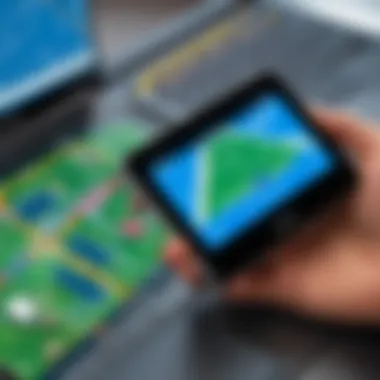Understanding GPS and GLONASS: A Comprehensive Overview


Intro
In today's interconnected world, understanding navigation systems is critical. Global Positioning System (GPS) and Global Navigation Satellite System (GLONASS) provide essential services that enhance not only personal navigation but also various sectors including transportation, agriculture, and telecommunications. Grasping their operational principles and differences can shed light on how they integrate and interact with everyday technology.
This overview goes beyond the basics, elucidating the technologies involved, their geographic reach, and advancements that impact accuracy. It is aimed at providing insights not only to tech-savvy individuals and gadget enthusiasts but also to anyone keen to comprehend the significant role of satellite navigation today.
Key Features
Design and Build Quality
The robustness of GPS and GLONASS technologies stems from their intricate design that involves a network of satellites in orbit. GPS operates with a constellation of at least 24 satellites, while GLONASS utilizes around 30. This difference in configuration affects their overall coverage and reliability.
Both systems are built to withstand extreme weather conditions, ensuring that signals remain operational regardless of environmental challenges. For instance, GPS satellites are designed to function at approximately 20,200 kilometers above Earth, while GLONASS satellites orbit slightly lower, at around 19,100 kilometers.
Display and Performance
Though GPS and GLONASS share similar functionalities, their display performance can vary based on the devices utilizing these systems. Most smartphones and modern navigation units incorporate capability for multi-GNSS, which means they can use signals from both GPS and GLONASS.
Such integration typically results in improved accuracy and reduced time to result, especially in environments with limited visibility, such as urban areas with tall buildings or dense forests. Devices that combine these systems can deliver a positioning accuracy within a few meters, an improvement over those relying solely on one system.
Product Specifications
Technical Specifications
The technical specifications of GPS and GLONASS specify not only their frequencies and signal structures but also the positioning accuracy they offer.
- GPS frequencies: L1, L2, L5
- GLONASS frequencies: L1, L2, L3, L4
Both systems utilize signals that are transmitted at specific frequencies, enabling positioning data to be calculated via triangulation. It is crucial to note that GLONASS operates with a slightly different frequency arrangement, which can affect performance depending on geographical location.
Compatibility and Connectivity
When employing GNSS in consumer technology, compatibility is paramount. Most contemporary devices, particularly smartphones from manufacturers such as Apple and Samsung, feature integrated chips that support both GPS and GLONASS. This dual capability enhances navigation performance and offers a seamless experience for users.
"Having GPS and GLONASS working together provides a greater safety net, making navigation more dependable during critical moments."
Additionally, many automotive navigation systems are engineered to utilize both to ensure users benefit from the best available signal. Always check manufacturer specifications to ensure full compatibility with your devices.
Prologue to Satellite Navigation
Satellite navigation has reshaped the way we perceive and interact with our environment. It encompasses a system of satellites that provide geolocation and time information to a GPS or GNSS receiver, which is commonly found in many modern devices. Understanding the principles and functionalities of satellite navigation becomes paramount in a world increasingly driven by technology.
This section aims to dissect the significance of navigation systems in daily life. We will explore the core reasons why these systems are necessary, the technical processes behind them, and how they have evolved to meet the demands of various sectors.
The Need for Navigation Systems
In today’s fast-paced society, navigation systems serve crucial functions across multiple fields. From transport to telecommunications, their impact is profound. Several key elements underscore the necessity:
- Accuracy: Precision in navigation is paramount. Whether for vehicular navigation or aircraft routing, accurate positioning reduces the risk of accidents.
- Efficiency: Navigation systems optimize routing, reducing travel time and fuel consumption.
- Safety: Emergency services rely on GPS for locating incidents swiftly, minimizing response times.
- Economy: Industries such as logistics benefit economically from optimized delivery routes, streamlining operations.
In essence, the need for these systems can be distilled down to the enhancement of safety, efficiency, and overall productivity in various operations.
How Satellite Navigation Works
The functioning of satellite navigation is grounded in several fundamental principles. At its core, it primarily involves the transmission of signals from satellites to ground-based receivers. The process unfolds in various stages:
- Satellite Network: A constellation of satellites orbits the Earth, each continually transmitting signals containing time and positioning data.
- Signal Transmission: The receiver calculates its position based on the time delay between signal transmission and reception. This involves triangulation principles, requiring signals from multiple satellites to determine a precise location.
- Data Processing: The receiver uses algorithms to process the incoming data, ultimately providing the user with accurate geographical coordinates.
The clarity of this process demonstrates how satellite navigation systems surpass traditional methods. The reliance on satellites for data transmission adds an element of reliability and accuracy that is less often found in older systems. As these technologies advance, users can expect improved responses and functionality in a variety of applications.
Overview of GPS
The Global Positioning System (GPS) stands as a cornerstone in modern navigation technology. It is vital not only to consumers but also to various industries. Understanding GPS provides insights into its historical context, technical structure, and the advantages and limitations it presents.
GPS is often characterized by its robustness and widespread adoption. It is frequently relied upon for location accuracy across multiple applications, ranging from everyday smartphone navigation to critical logistics and military operations. Knowing how GPS evolved and operates can offer a deeper appreciation for its capabilities.


History and Development of GPS
GPS was initially developed by the United States Department of Defense. Its origins trace back to the 1970s, with the first satellite launched in 1978. As the system matured, it transitioned from a purely military tool to a vital public resource during the 1990s. The full constellation of satellites became functional in the mid-1990s, which significantly improved accuracy and availability.
Over the decades, GPS technology witnessed continuous refinements. These improvements typically focused on increasing precision and reducing latency. The introduction of civilian signals allowed broader applications and stimulated the growth of various industries that depend on accurate location data.
Technical Structure of GPS
The technical structure of GPS is composed of three main components: satellites, ground stations, and receivers. Each element plays a critical role in ensuring the system operates effectively.
Satellites
GPS satellites are orbiting at an altitude of approximately 20,200 kilometers. A total of 31 satellites belong to the operational constellation. A key characteristic of these satellites is that they are designed to operate for 10 to 15 years.
Their unique feature lies in the precise atomic clocks onboard, which maintain time to a high degree of accuracy. This is essential for determining the position of objects on Earth. However, a drawback is the requirement for regular maintenance and updates to ensure reliability.
Ground Stations
Ground stations monitor the satellites and are instrumental in maintaining their orbits. These stations are spread globally, allowing for constant oversight. Notably, ground stations keep track of the satellite's operational status.
One defining feature is their ability to handle real-time data, ensuring that the satellites remain synchronized. However, the dependence on the terrestrial infrastructure may be a limitation, especially in remote areas where stations are less accessible.
Receivers
Receivers are devices that pick up signals from GPS satellites. They can vary from simple handheld devices to sophisticated systems used in aviation and maritime navigation. A distinguishing characteristic of receivers is their ability to decode signals from multiple satellites, enhancing accuracy.
A unique advantage of modern receivers is their integration with other technologies, such as smartphones and automotive systems. This allows for seamless navigation across various platforms. On the downside, receivers can sometimes struggle with signal obstructions from buildings or natural features.
Accuracy and Limitations of GPS
GPS is widely recognized for its accuracy, but it is important to understand the factors that can influence its performance.
Factors Affecting Accuracy
A number of variables can impact GPS accuracy. This includes atmospheric conditions, signal delay, and satellite geometry. For instance, when signals pass through layers of the atmosphere, they can experience delays which affect the final positioning data.
The key characteristic of these factors is that they are often situational and can be influenced by weather conditions. Understanding these nuances allows users to have realistic expectations regarding GPS functionality.
Possible Deviations
Possible deviations in GPS outputs are not uncommon. They can arise from inaccuracies caused by multipath signals, where reflections off buildings distort positioning data. The unique feature of these deviations is that they can occur in urban environments, where dense structures exist.
A significant advantage to acknowledging these deviations is that users can take measures to mitigate their effects. Employing techniques such as differential GPS can improve precision, albeit with added complexity.
"Recognizing both the strengths and weaknesses of GPS technology leads to better utilization and enhanced understanding of navigation systems in diverse contexts."
Exploring GLONASS
The exploration of GLONASS is crucial for understanding satellite navigation systems. GLONASS is Russia's counterpart to the widely recognized Global Positioning System (GPS). It provides global coverage and enhances navigation reliability. Understanding GLONASS means grasping its unique benefits and specific operational mechanisms. This section will delve into the background, technical framework, and a comparative analysis of accuracy between GPS and GLONASS.
Background and Evolution of GLONASS
GLONASS was initiated in the 1970s as a response to the need for a robust and reliable satellite navigation system. It became operational in the 1990s. Russia aimed to create an independent system to provide precise positioning, navigation, and timing services. Over the years, its network of satellites expanded, enhancing coverage and reliability. Currently, GLONASS comprises 30 satellites in orbit, with various generations in operation. The user community for GLONASS extends beyond Russia, catering to global users who require accurate positioning data.
GLONASS Technical Framework
Satellite Configuration
The satellite configuration of GLONASS is vital for its operational success. The system includes satellites spaced in such a way to ensure that at least four satellites are visible from any point on Earth. This characteristic is suitable for providing dependable navigation data. Each satellite has a unique orbital slot, allowing for minimal signal interference and optimal coverage. The design is particularly beneficial in regions where GPS coverage may be lacking, such as high latitudes. However, it is essential to note that the rotation period of GLONASS satellites differs from GPS, which can slightly affect time synchronization.
Operational Control Centers
Operational control centers are the backbone of GLONASS's functionality. These centers monitor the satellite performance, manage the network's integrity, and carry out necessary updates. The key characteristic that stands out is their active ability to control and assess satellite operation in real-time. This capability ensures that the satellites remain accurate and reliable. Each center collaborates closely with others, providing redundancy and continuous monitoring. One unique aspect of these centers is their role in user-level data dissemination. This function can lead to a more responsive service for users but requires consistent maintenance and updates.
User Equipment


User equipment in the context of GLONASS plays a significant role in its overall utility. Devices capable of receiving GLONASS signals include various smartphones, car navigation systems, and specialized survey equipment. The key characteristic of user equipment is its adaptability to combine signals from both GPS and GLONASS. This flexibility enhances accuracy and provides better positioning in challenging environments, such as urban canyons. One unique feature of GLONASS-compatible devices is their ability to maintain functionality even when GPS signals are weak or obstructed, offering significant advantages in real-world applications.
Comparative Analysis of GPS and GLONASS Accuracy
A comparative analysis of GPS and GLONASS highlights significant aspects in accuracy and reliability. In areas with sufficient satellite coverage, both systems provide reliable location data. However, due to different satellite configurations, the performance can vary depending on geographical location. For example, GLONASS tends to perform better in higher latitudes where GPS signals can be compromised. Furthermore, the integration of both systems offers improved accuracy and reliability for users. Combining signals from multiple systems reduces the likelihood of errors caused by satellite geometry. As technology advances, the collaboration between GPS and GLONASS will continue to improve navigational capabilities for users globally.
Integration of GPS and GLONASS
The integration of GPS and GLONASS represents a significant advancement in satellite navigation technology. Combining these two systems enhances overall accuracy and reliability, providing users with improved navigation capabilities. The interoperability of GPS and GLONASS allows for the utilization of multiple satellite signals, leading to more robust solutions in various applications.
Dual-Mode Navigation Systems
Dual-mode navigation systems are designed to leverage both GPS and GLONASS signals simultaneously. This capability ensures that users can access a broader array of satellites, effectively reducing the likelihood of signal loss in challenging environments. For instance, in urban areas with tall buildings or in dense forests, having access to both systems minimizes the impact of obstruction. Significant investments in technology now enable devices, especially smartphones and automotive systems, to process signals from both systems swiftly.
Benefits of Combined Systems
Increased Accuracy
Increased accuracy is a central advantage of combining GPS and GLONASS. When both systems are utilized, users benefit from improved positional data, essential for applications demanding precision, like surveying or autonomous driving. The key characteristic of increased accuracy is its ability to provide a more reliable positional fix. This reliability stems from the increased number of visible satellites, which enhances triangulation capabilities. As a result, this dual-system approach is considered a popular choice among those seeking high standards for accuracy in navigation solutions. Furthermore, the unique feature of increased accuracy lies in its responsiveness, especially in dynamic scenarios like driving, where immediate positional adjustments are often required.
Improved Reliability
Improved reliability further exemplifies the benefits of integrating GPS and GLONASS. This aspect ensures that users experience consistent performance, even in less-than-ideal conditions. The essential characteristic of improved reliability is its capacity to maintain signal integrity despite potential disruptions. This feature is beneficial, especially in critical operations, such as in transportation and emergency services, where reliable navigation is non-negotiable. While increased reliability enhances user trust, it is important to acknowledge its unique advantage of minimizing signal dropouts, particularly during challenging weather conditions. Overreliance on a single system can expose users to vulnerabilities.
The integration of GPS and GLONASS is not just about redundancy; it's about ensuring increasingly precise and dependable navigation, vital for the evolving technological landscape.
The ongoing evolution of satellite navigation technologies signifies the need for adaptability. By combining these two systems, end-users can experience superior navigation solutions tailored to meet diverse needs, from personal use to complex industrial applications.
Applications of GPS and GLONASS
The practical use of GPS and GLONASS extends throughout many aspects of life and industry today. Their applications are significant not only in personal technology but also in a wide range of sectors such as agriculture, transportation, and military operations. Understanding these applications highlights the value these systems provide.
Consumer Technology Implementation
Smartphones
Smartphones have integrated GPS technology as a core functionality. This allows users to effortlessly navigate their surroundings, access location-based services, and track fitness activities. The key characteristic of smartphones is their multifunctionality, serving as communication devices and portable navigational tools. This makes them a beneficial choice for accessing GPS data on the go. A unique feature of smartphones is their ability to utilize both GPS and GLONASS signals to improve positioning accuracy. Advantages include quicker location fixes and enhanced performance in challenging environments, while the disadvantages may include battery consumption from constant GPS usage.
Automotive Navigation
Automotive navigation systems represent another significant application of GPS and GLONASS. Cars equipped with these systems provide real-time navigation and traffic updates, improving travel efficiency. A key characteristic of automotive navigation is its ability to offer turn-by-turn directions. This feature is popular due to its ease of use and real-time updates. The most noteworthy unique feature is the integration with vehicle diagnostic systems, allowing for a seamless driving experience. The advantages here are accurate route guidance and efficient time management, while potential disadvantages might include reliance on frequent software updates and occasional inaccuracies in remote areas.
Industrial and Commercial Uses
Agriculture
In agriculture, GPS and GLONASS technologies enhance efficiency in farming practices. They enable precision agriculture, allowing farmers to optimize field-level management regarding crop farming. The key characteristic of this application is its ability to facilitate accurate planting and harvesting. This is a beneficial choice for maximizing yields and resource management. A unique feature of agricultural GPS is its integration with drones for crop monitoring. Advantages include reduced waste of seeds and fertilizers, while disadvantages may involve the costs of implementing such advanced systems.
Transportation Logistics
Transportation logistics benefit greatly from GPS and GLONASS technologies, ensuring efficient management of fleets. These systems allow for optimal routing and tracking of deliveries. A key characteristic here is real-time visibility of shipment locations. This makes it a critical component for logistics companies. The unique feature of logistics tracking is its ability to provide Estimated Time of Arrival (ETA) updates. Advantages include cost savings and enhanced customer satisfaction, while disadvantages can occur when external factors lead to signal losses or errors in the data.
Construction
In the construction industry, GPS and GLONASS are crucial for project management and site surveying. They provide accuracy in mapping and layout. A key characteristic of using these technologies in construction is enhanced precision in site mapping. This is a beneficial aspect, as even small errors can lead to significant project delays. The unique feature here includes the ability to create detailed 3D site models. Advantages of this technology include better resource allocation, while potential disadvantages might involve the need for trained personnel to use and maintain the systems.
Military Applications
Surveillance
In military contexts, GPS and GLONASS foster enhanced surveillance capabilities. These systems provide real-time location data, enabling effective monitoring of large areas. A key characteristic of military surveillance is its ability to work in conjunction with other intelligence systems. This makes it an essential tool for strategic operations. The unique feature is the level of accuracy provided for dynamic operations. Advantages include improved situational awareness, while disadvantages can arise from reliance on technology that may be vulnerable to jamming.
Targeting
Targeting in military applications also relies heavily on precise location data from GPS and GLONASS. This capability improves the effectiveness of operations involving munitions. A key characteristic of this application is the integration of these technologies with advanced weapon systems. This enhances targeting precision overall. The unique feature here is the enforcement of stricter controls on munitions deployment. Advantages include reduced collateral damage, whereas disadvantages may entail ethical considerations and the risk of reliance on technology.


The blending of GPS and GLONASS technologies in various sectors underscores their importance in optimizing processes and improving outcomes.
Future Trends in Satellite Navigation
The domain of satellite navigation is poised for significant advancements. With evolving technology, the future of GPS and GLONASS will shape the way we navigate, impacting both consumers and industries. The competitive landscape ensures a progressive enhancement in navigation capabilities, making it essential to examine the expected trends and their implications.
Emerging Technologies
Emerging technologies play a pivotal role in the evolution of satellite navigation systems. Innovations such as next-gen satellites are being designed to improve signal reliability and reduce vulnerabilities. For instance, the integration of low Earth orbit (LEO) satellite constellations could provide faster and more accurate location data. This framework contrasts with the traditional medium Earth orbit satellites used by GPS and GLONASS. LEO satellites can offer enhanced coverage, especially in urban environments with high buildings that tend to obstruct signals.
Another significant technology on the rise is inter-satellite links (ISLs). These links enable satellites to communicate directly with each other. With ISLs, the system can relay information rapidly, enhancing positioning capabilities and minimizing signal delays. Furthermore, advancements in miniaturized sensors and improved antennas enhance the performance of receiving devices, allowing for better precision in diverse environments.
Potential Improvements in Accuracy
Improving accuracy remains a key objective in satellite navigation technology. Several methods are being explored to achieve this goal. For example, integrating multi-frequency signals can offer better accuracy compared to single-frequency systems. GPS already uses multiple frequencies, and GLONASS is following suit. Different frequencies can mitigate errors caused by atmospheric interference, enhancing signal clarity.
Additionally, augmentation systems such as WAAS (Wide Area Augmentation System) or EGNOS (European Geostationary Navigation Overlay Service) improve accuracy significantly. These systems correct position data in real-time, allowing users to achieve sub-meter accuracy.
As technologies like real-time kinematic positioning (RTK) gain traction, users in fields like agriculture and surveying will access centimeter-level accuracy.
"The quest for accuracy is ongoing, with new technologies emerging to push the boundaries of what is possible in satellite navigation systems."
The Role of Commercial Entities
Commercial entities increasingly influence the development of satellite navigation systems. Major tech companies, such as Apple and Google, are investing resources into R&D to improve navigation services on consumer devices.
These organizations are exploring ways to make navigation more precise and accessible. Their contributions include creating powerful algorithms and innovative applications that utilize GPS and GLONASS data effectively.
Moreover, startups focusing on satellite-based technologies are addressing gaps in conventional navigation systems. For instance, the use of crowdsourced data in navigation applications not only enhances accuracy but also provides real-time updates on traffic conditions and obstacles. As commercial interests converge with technological advancements, users can expect a more versatile navigation experience.
With the rise of smart cities and autonomous vehicles, the demand for sophisticated navigation systems will increase. Companies involved in satellite technology will likely collaborate more closely with urban planners and automotive manufacturers to create integrated solutions that prioritize accuracy and efficiency.
Challenges Facing GPS and GLONASS
The significance of understanding the challenges faced by GPS and GLONASS cannot be understated. As reliance on these navigation systems increases across various sectors such as agriculture, transportation, and personal devices, comprehending the limitations and obstacles inherent in their operation becomes essential. This section will delve into specific issues that impact the functionality and trustworthiness of GPS and GLONASS, namely signal interference and geopolitical concerns.
Signal Interference and Multipath Effects
One primary challenge affecting both GPS and GLONASS is signal interference. External factors, such as buildings, trees, and even weather conditions, can disrupt satellite signals. This disruption is often termed as multiplicative effects. The satellite signals bounce off obstacles before reaching the receivers, leading to inaccuracies in position determination.
Key aspects of signal interference include:
- Obstruction: Tall buildings or dense foliage can block the direct line of sight between satellites and receivers, reducing the signal’s strength.
- Electromagnetic interference: Urban environments often have numerous sources of radio frequency interference, which can distort the satellite signals.
- Multipath propagation: When signals take multiple paths to reach the receiver, it can result in incorrect positioning, known as multipath errors.
Mitigating these effects requires advanced signal processing techniques that seek to filter out the noise and improve the accuracy of positioning. Technologies like differential GPS have emerged to counteract some of these problems, but they cannot eliminate them completely.
"The accuracy of satellite navigation systems is paramount. Factors such as signal interference must be addressed to maintain user trust and system reliability."
Geopolitical Concerns
Another critical challenge relates to the geopolitical landscape in which GPS and GLONASS operate. As these systems are not just technological tools but also strategic assets, their operation is often influenced by international relations.
Several key geopolitical concerns include:
- Dependency: Many countries rely on the United States’ GPS for everyday navigation needs. This dependency raises concerns over national security and sovereignty, particularly for countries that have contentious relationships with the United States.
- Military Use: Both GPS and GLONASS have significant applications in military operations. Control over these systems can impact military strategy and operations, giving rise to security and operational risks.
- Global Cooperation and Competition: While these navigation systems enhance global connectivity, they also create a competitive environment, with nations competing to develop and improve their satellite navigation capabilities.
Addressing these geopolitical concerns involves fostering international cooperation and transparency in satellite navigation practices while ensuring that nations maintain independent capabilities to avoid over-reliance on a single system. Understanding these complexities is essential for enhancing the global navigation landscape.
In summary, as we navigate our increasingly connected world, addressing the challenges of signal interference and geopolitical factors is vital for the ongoing reliability and efficacy of GPS and GLONASS.
Culmination
In this comprehensive overview, we emphasize the fundamental principles and operational frameworks of GPS and GLONASS, two pivotal technologies in satellite navigation. The significance of these systems cannot be overstated, given their impact on multiple sectors such as transportation, agriculture, and military operations. Readers must understand the technical details both for appreciation of the technology and for its broader implications in today’s context.
Summary of Key Insights
We have covered various aspects of GPS and GLONASS. Key points include:
- Historical Development: GPS was initiated by the U.S. Department of Defense in the 1970s. GLONASS followed in the 1980s by the Russian Federation.
- Technical Structure: Both systems utilize a network of satellites orbiting the Earth, along with ground stations and user equipment to compute positions.
- Accuracy Factors: GPS typically offers a positional accuracy within 5 to 10 meters under optimal conditions, while GLONASS has its strengths and weaknesses influenced by similar variables.
- Integration Benefits: Using both GPS and GLONASS enhances reliability and accuracy, making dual-mode navigation systems increasingly common in consumer technology.
- Real-World Applications: These systems facilitate everything from smartphone navigation to autonomous vehicles, demonstrating their versatility.
- Challenges: Signal interference, geopolitical tensions, and technological limitations pose ongoing challenges to reliable navigation.
Final Thoughts on the Future of Navigation
The future of satellite navigation systems will likely be shaped by several trends. Advancements in technology, such as the introduction of new satellite constellations and improved accuracy algorithms, promise to enhance the functionality of GPS and GLONASS. Moreover, as commercial entities continue to enter the field, competition may drive further innovations. The growing integration of artificial intelligence and machine learning could revolutionize how navigation data is processed and utilized. Understanding these dynamics and being adaptive to them will be essential for leveraging the potential of satellite navigation in the years to come.



